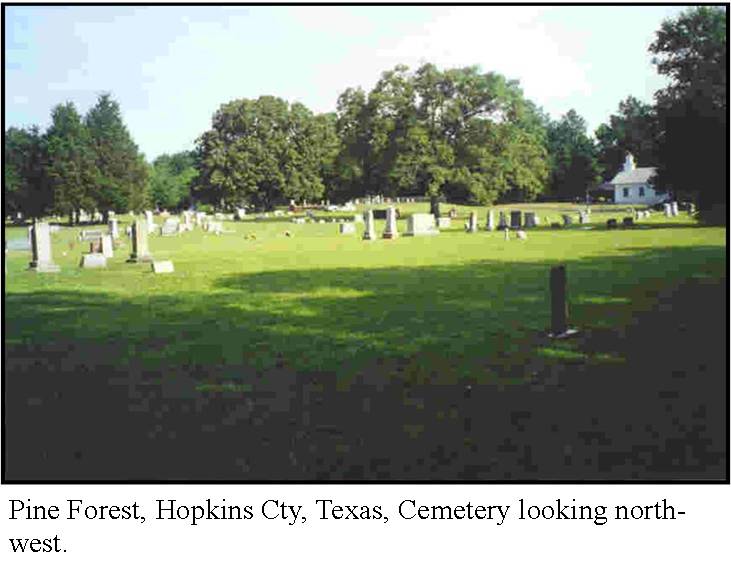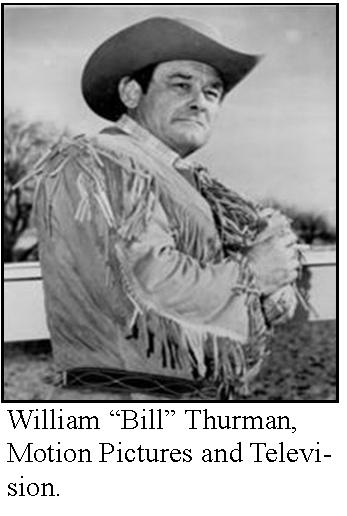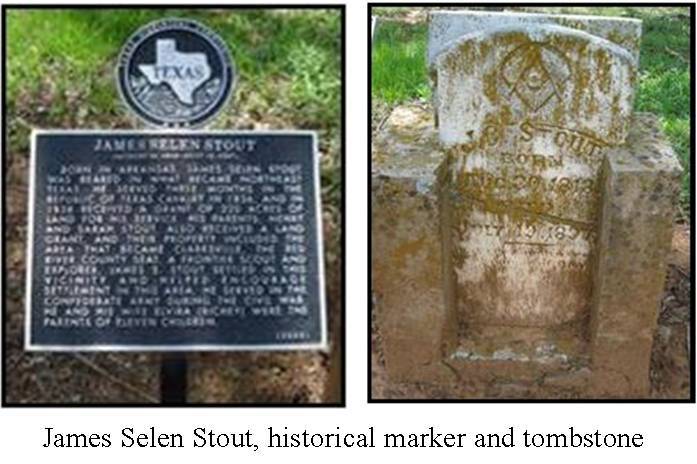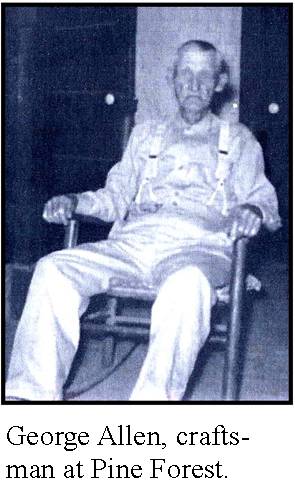Cemeteries Have Their Own Lives
By Thomas J. Minter
“The fence around a cemetery is foolish, for those inside can’t
get out and those outside don’t want to get in.” — Arthur Brisbane
People do not think a lot about cemeteries or visiting them, probably because they are stark reminders of one’s mortality. And besides there is not much going on in them. Yet most graveyards have interesting histories and stories to tell.
 Pine Forest Cemetery is a case in point. The cemetery is located in Hopkins County Texas 4 miles south of I-30 near Weaver, Texas. It is at the town of Pine Forest, which has seen its heyday. The cemetery is off of FM-269 about an eighth of a mile, and is across the road from a small white Methodist church. At the entrance to the cemetery there is a state historical marker, which states among other salient facts, that the land for the church and cemetery was donated by Thomas Willison in 1855.
Pine Forest Cemetery is a case in point. The cemetery is located in Hopkins County Texas 4 miles south of I-30 near Weaver, Texas. It is at the town of Pine Forest, which has seen its heyday. The cemetery is off of FM-269 about an eighth of a mile, and is across the road from a small white Methodist church. At the entrance to the cemetery there is a state historical marker, which states among other salient facts, that the land for the church and cemetery was donated by Thomas Willison in 1855.
 As you approach the cemetery the road is of a slight incline. This is where the cemetery’s earliest graves are situated. And as with most older cemeteries, the burial sites are marked with small unpolished grave stones, some of which are sandstone and the names chiseled on them are hardly legible. Some bear inscriptions such as “A friend to all, an enemy to none” and with the case of a 16 year old, “Just in the morning of his day, in youth he died.” And for a 3 year old, “Our darling one has gone before to greet us.” Throughout the cemetery tombstones bear given names such as Prudence, Addie, Deryl, Tobe, Omega, and Ovis, which are seldom heard today, but were probably popular in their day. These etched tombstones speak of an early time.
As you approach the cemetery the road is of a slight incline. This is where the cemetery’s earliest graves are situated. And as with most older cemeteries, the burial sites are marked with small unpolished grave stones, some of which are sandstone and the names chiseled on them are hardly legible. Some bear inscriptions such as “A friend to all, an enemy to none” and with the case of a 16 year old, “Just in the morning of his day, in youth he died.” And for a 3 year old, “Our darling one has gone before to greet us.” Throughout the cemetery tombstones bear given names such as Prudence, Addie, Deryl, Tobe, Omega, and Ovis, which are seldom heard today, but were probably popular in their day. These etched tombstones speak of an early time.

There are differing stories about who was the first person laid to rest here. Across the road from these graves is a spring, and it is said that a family who was travelling had stopped at the spring to camp and young girl had died, and she was taken across the road and buried. Another story involves a man at the spring who was injured and subsequently died. And he too was buried across the road, with the grave being marked with a large black rock. I examined this area of the cemetery several years ago and could not find any such rock. This is not farfetched though, for in early days graves were marked with rocks. Woodland Cemetery a few miles southwest of Pine Forest Cemetery has a few graves simply marked with stones.
 John Morgan Minter who died on August 27, 1856 is said to be the first
John Morgan Minter who died on August 27, 1856 is said to be the first
known grave in the cemetery, where a person’s name and dates of birth and
death are known. The second known grave is that of Robert Junell (1823-1857).
 The grave of the most famous person in Pine Forest cemetery is probably
The grave of the most famous person in Pine Forest cemetery is probably
that of Bill Thurman (1920-1995) character/bit parts actor. Among his dozens
of credits are The Last Picture Show (1971), Tom Horn (1980), and Where the
Red Fern Grows (1974).
 Sometimes people claim that a person was buried in a cemetery, but they
Sometimes people claim that a person was buried in a cemetery, but they
cannot find their grave. This is not uncommon. Katherine H. Minter, who
was born in 1825 and died after 1870, should have a grave marker where
her immediate family is buried, but does not. You would expect to find one
because she never married and was probably mentally impaired as she had
a guardian.
 There are explanations for things like this other than one simply being mistaken. In the 1940’s a man was hired to mow around the graves in the Pine Forest Cemetery with a horse-drawn mower. In this process several grave stones were knocked over and strewn about. Instead of trying to put the stones back in their rightful location, he simply piled them along a fence row. Later in that same decade a flash flood swirled over the western edge of the cemetery, where the terrain is low, and dislocated some tomb stones. This resulted in some graves being moved to higher ground. Jack E. Turner (1870-1945) was one of the graves moved. Also in some cemeteries vandals have been known to contribute confusion as to burial sites.
There are explanations for things like this other than one simply being mistaken. In the 1940’s a man was hired to mow around the graves in the Pine Forest Cemetery with a horse-drawn mower. In this process several grave stones were knocked over and strewn about. Instead of trying to put the stones back in their rightful location, he simply piled them along a fence row. Later in that same decade a flash flood swirled over the western edge of the cemetery, where the terrain is low, and dislocated some tomb stones. This resulted in some graves being moved to higher ground. Jack E. Turner (1870-1945) was one of the graves moved. Also in some cemeteries vandals have been known to contribute confusion as to burial sites.
 In 1906 Dr. Meredith C. Reneau was buried on the mid south side of the cemetery. Earlier Dr. Reneau, one of the town’s first physicians and owner of its early cotton gin, planted a mulberry tree in the cemetery, and said, “this is where I want to be buried.” He was, and as of 1952 the mulberry tree still existed.
In 1906 Dr. Meredith C. Reneau was buried on the mid south side of the cemetery. Earlier Dr. Reneau, one of the town’s first physicians and owner of its early cotton gin, planted a mulberry tree in the cemetery, and said, “this is where I want to be buried.” He was, and as of 1952 the mulberry tree still existed.
 From January 1918 to December of 1920 a flu pandemic swept the world in two waves. An estimated 100 million people died worldwide, and from 500,000 to 675,00 succumbed in the United States. Instead of taking its biggest toll of the elderly and the young, this scourge hit the young healthy adult mostly.
From January 1918 to December of 1920 a flu pandemic swept the world in two waves. An estimated 100 million people died worldwide, and from 500,000 to 675,00 succumbed in the United States. Instead of taking its biggest toll of the elderly and the young, this scourge hit the young healthy adult mostly.
 If you stroll through cemeteries started before this time period, you will see some graves as a result of this flu outbreak. Of the 815 interments in the Pine Forest Cemetery, 17 people died and were buried in the time period of the pandemic. Five of these deaths fit the category of young adults.
If you stroll through cemeteries started before this time period, you will see some graves as a result of this flu outbreak. Of the 815 interments in the Pine Forest Cemetery, 17 people died and were buried in the time period of the pandemic. Five of these deaths fit the category of young adults.
 In the late 1940’s a mother, whose husband was deceased, and her grown daughter had the same suitor, who was several years older than the daughter and few years younger than the mother. The daughter won out, and married the man. The daughter died before the mother, and the mother who was still peeved over the situation refused to allow the daughter to be buried in the family plot. As a result the daughter was interred in another part of the cemetery. Later, the mother relented, and the body of the daughter was exhumed and re-buried next to her family. After the body was exhumed, it sat overnight in the cemetery. And it has been told that the stench that hung over the cemetery was unmistaken and stifling. I cannot attest to the veracity of this story, but I have found two different tombstones in the cemetery for the daughter. This tale might be filed under “gossip,” as all the facts are not fully known.
In the late 1940’s a mother, whose husband was deceased, and her grown daughter had the same suitor, who was several years older than the daughter and few years younger than the mother. The daughter won out, and married the man. The daughter died before the mother, and the mother who was still peeved over the situation refused to allow the daughter to be buried in the family plot. As a result the daughter was interred in another part of the cemetery. Later, the mother relented, and the body of the daughter was exhumed and re-buried next to her family. After the body was exhumed, it sat overnight in the cemetery. And it has been told that the stench that hung over the cemetery was unmistaken and stifling. I cannot attest to the veracity of this story, but I have found two different tombstones in the cemetery for the daughter. This tale might be filed under “gossip,” as all the facts are not fully known.

The Pine Forest Cemetery is the resting place of James Selen Stout (1818-1897 ) who was a scout in the early settlement of East Texas. He accompanied many families to the area from the north across the Red River. He was later instrumental in helping to establish schools and roads in the Pine Forest area. Beside his grave a state historical marker stands, like a sentinel, extolling the highlights of his life.
 There are many graves in the cemetery of servicemen. These include veterans of the Mexican War (1), Civil War (3), WWI (5), WWII 30), Korea (4), and Viet Nam (2). There is one grave whose occupant fought in the Texas Indian Creek battle of 1841. These numbers are tallied from what appears on the gravestones—if all who served were known, the numbers would increase significantly.
There are many graves in the cemetery of servicemen. These include veterans of the Mexican War (1), Civil War (3), WWI (5), WWII 30), Korea (4), and Viet Nam (2). There is one grave whose occupant fought in the Texas Indian Creek battle of 1841. These numbers are tallied from what appears on the gravestones—if all who served were known, the numbers would increase significantly.
 Many of the coffins in this cemetery were the handiwork of George W. Allen
Many of the coffins in this cemetery were the handiwork of George W. Allen
(1864-1953), a craftsman of renown, who also made thousands of brick and many
wooden door latches for the community. George lies on the east side of the cemetery.
 Like many cemeteries, Pine Forest has a cleanup day, where citizens remove
Like many cemeteries, Pine Forest has a cleanup day, where citizens remove
rubbish, cut weeds and brush, and fix fence and so on. This is usually in early
summer. In some cases a pot luck lunch is part of the occasion. And in earlier years
candidates for public office joined in the festivities, introducing themselves and
handing out their cards.
 My Minter ancestors were numerous in the Pine Forest area in the past.
My Minter ancestors were numerous in the Pine Forest area in the past.
Over 75 gravesites in the cemetery are of my blood relatives. There are many
stories about them. Emmett Minter who was murdered in 1945 is buried there.
Gus Minter the story teller, who died in 1929 has a place in the cemetery. Pappy
Minter (1818-1888 ), who had a grist mill at the spring across the road during
the Civil War, occupies a gravesite.
 Learning about cemeteries gets easier each year as more and more infor-
Learning about cemeteries gets easier each year as more and more infor-
mation is posted on Internet websites about individual graves and graveyards.
www.findagrave.com is one such website. June England Tuck of Hopkins
County has done much research and has written extensively about cemeteries
in the county.





